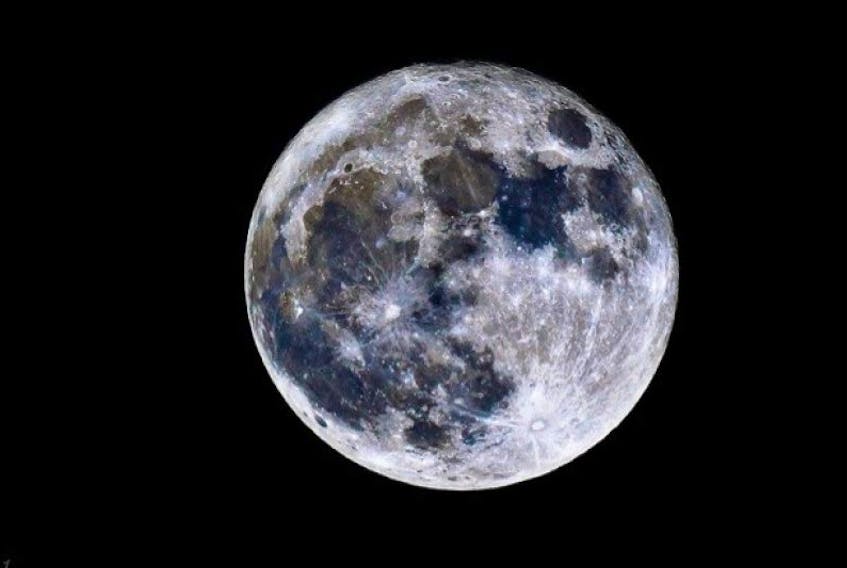As darkness now starts to fall a bit earlier each evening throughout September, the night’s longer hours provide a greater opportunity to view the wonders of the night sky.
Autumn is a splendid time of the year to get out after dark and, with either the naked eye, binoculars or a telescope, familiarize ourselves with the various constellations, planets, star clusters or galaxies. The moon is a magnificent sight in binoculars, and a view of its many craters and mountain ranges in a telescope (even a cheap department store model) is captivating. The chance of glimpsing a comet as it slowly drifts across the night sky or lying on a blanket in the backyard to watch a dazzling display of meteors is sure to leave you with a sense of just how big, and how utterly mind-blowing, the cosmos in which we live truly is.
The last super moon of 2014 occurs on the evening of Sept. 8, when the full moon reaches perigee, its closest approach to Earth for the month. There were four other super moons throughout the year (two in January, one in July, and one in August). September’s super moon is the harvest moon, providing extra light throughout the night for farmers trying to get their crops in. It also heralds the approaching autumnal equinox, the start of autumn, which follows two weeks later on Sept. 22.
As evening twilight falls this month, look to the west. Mercury (mag. 0.0) sits low (a mere 3 degrees) above the western horizon about a half hour after sunset. Although Mercury reaches its greatest eastern elongation from the sun on Sept. 21, it continues to hug the horizon. Binoculars will definitely help you spot this shy planet. The crescent moon sits to the upper left of Mercury on Sept. 26.
Saturn (mag. - 0.6), sits about 20 degrees (two hands’ width at arm’s length) above the south-western horizon as darkness falls (about one hour after sunset). Saturn and its magnificent ring system are best viewed during the first half of the month, for, as September progresses, it will appear lower in the evening sky. By month’s end, it will only be about 10 degrees above the horizon as darkness falls. Don’t miss the waxing, crescent moon sitting extremely close (less than 1 degree) to Saturn on Sept. 27.
As September opens, Mars sits off to the left of Saturn in the constellation of Libra – the Scales in the night sky. On Sept. 27, Mars passes just above Antares, the giant 1st magnitude red star in the constellation of Scorpius – the Scorpion. Use binoculars to compare the red colours of both these two celestial objects. The crescent moon passes above both Mars and Antares on Sept. 29.
Mighty Jupiter (mag. - 1.8) rises in the east about one hour before morning twilight (approx. 4 a.m.) during early September. On Sept. 15, Jupiter lies about three degrees east-southeast of the famous Beehive star cluster (M44) in the constellation of Cancer – the Crab.
Both Jupiter and M44 should fit within the same field of view in your binoculars. By month’s end, these two objects will have drifted apart (as seen from Earth). Jupiter climbs higher in the pre-dawn sky as September progresses.
The best views of this magnificent planet and its four largest moons will come in the last week of the month, when it will sit about 30 degrees above the eastern horizon at the start of morning twilight.
Just making it under the wire, Venus (mag. -3.9) makes her brilliant appearance above the eastern horizon (about 15 degrees to the lower left of Jupiter) during morning twilight (around 5 a.m.). You will have to be quick to catch a glimpse of our ‘morning star,’ as with each passing day, Venus slips deeper into the twilight, so that, by month’s end, it is lost in the glare of the rising sun.
As mentioned above, for us here in the northern hemisphere, the official start to autumn, the autumnal equinox occurs at 11:29 a.m. on Sept. 22. This is the exact time when the sun crosses the celestial equator heading south, and when there are nearly equal amounts of daylight and darkness across the globe. To find out more about equinoxes, Google it on the Internet.
Comet PANSTARRS (C/2012 K1) should reach 6.0 mag. this month, when it comes into view before dawn during the second half of the month. It will drift through the constellation of Hydra – the Serpent during September. To find out more about Comet K1, look for the comet’s finder charts at either www.astronomy.com or www.skyandtelescope.com or simply Google it.
Until next month, clear skies.
Events (ADT):
Sept. 8 - Super moon at perigee (closest to Earth); 356,307 kms., 12:31 a.m.;
Sept. 8 Full (harvest) moon, 10:38 p.m.;
Sept. 15 - Last Quarter Moon, 11:05 p.m.;
Sept. 20 - Moon at apogee (furthest from Earth); 403,488 kms., 11:22 a.m.;
Sept. 22 - Autumnal equinox; 11:29 a.m.;
Sept. 24 - New moon; 3:14 a.m.
Glenn K. Roberts is a member of the Charlottetown Centre of the Royal Astronomical Society of Canada (RASC). His column appears in The Guardian once a month. He welcomes comments from readers. Anyone who would like to comment on his column is encouraged to email him at [email protected].
As darkness now starts to fall a bit earlier each evening throughout September, the night’s longer hours provide a greater opportunity to view the wonders of the night sky.
Autumn is a splendid time of the year to get out after dark and, with either the naked eye, binoculars or a telescope, familiarize ourselves with the various constellations, planets, star clusters or galaxies. The moon is a magnificent sight in binoculars, and a view of its many craters and mountain ranges in a telescope (even a cheap department store model) is captivating. The chance of glimpsing a comet as it slowly drifts across the night sky or lying on a blanket in the backyard to watch a dazzling display of meteors is sure to leave you with a sense of just how big, and how utterly mind-blowing, the cosmos in which we live truly is.
The last super moon of 2014 occurs on the evening of Sept. 8, when the full moon reaches perigee, its closest approach to Earth for the month. There were four other super moons throughout the year (two in January, one in July, and one in August). September’s super moon is the harvest moon, providing extra light throughout the night for farmers trying to get their crops in. It also heralds the approaching autumnal equinox, the start of autumn, which follows two weeks later on Sept. 22.
As evening twilight falls this month, look to the west. Mercury (mag. 0.0) sits low (a mere 3 degrees) above the western horizon about a half hour after sunset. Although Mercury reaches its greatest eastern elongation from the sun on Sept. 21, it continues to hug the horizon. Binoculars will definitely help you spot this shy planet. The crescent moon sits to the upper left of Mercury on Sept. 26.
Saturn (mag. - 0.6), sits about 20 degrees (two hands’ width at arm’s length) above the south-western horizon as darkness falls (about one hour after sunset). Saturn and its magnificent ring system are best viewed during the first half of the month, for, as September progresses, it will appear lower in the evening sky. By month’s end, it will only be about 10 degrees above the horizon as darkness falls. Don’t miss the waxing, crescent moon sitting extremely close (less than 1 degree) to Saturn on Sept. 27.
As September opens, Mars sits off to the left of Saturn in the constellation of Libra – the Scales in the night sky. On Sept. 27, Mars passes just above Antares, the giant 1st magnitude red star in the constellation of Scorpius – the Scorpion. Use binoculars to compare the red colours of both these two celestial objects. The crescent moon passes above both Mars and Antares on Sept. 29.
Mighty Jupiter (mag. - 1.8) rises in the east about one hour before morning twilight (approx. 4 a.m.) during early September. On Sept. 15, Jupiter lies about three degrees east-southeast of the famous Beehive star cluster (M44) in the constellation of Cancer – the Crab.
Both Jupiter and M44 should fit within the same field of view in your binoculars. By month’s end, these two objects will have drifted apart (as seen from Earth). Jupiter climbs higher in the pre-dawn sky as September progresses.
The best views of this magnificent planet and its four largest moons will come in the last week of the month, when it will sit about 30 degrees above the eastern horizon at the start of morning twilight.
Just making it under the wire, Venus (mag. -3.9) makes her brilliant appearance above the eastern horizon (about 15 degrees to the lower left of Jupiter) during morning twilight (around 5 a.m.). You will have to be quick to catch a glimpse of our ‘morning star,’ as with each passing day, Venus slips deeper into the twilight, so that, by month’s end, it is lost in the glare of the rising sun.
As mentioned above, for us here in the northern hemisphere, the official start to autumn, the autumnal equinox occurs at 11:29 a.m. on Sept. 22. This is the exact time when the sun crosses the celestial equator heading south, and when there are nearly equal amounts of daylight and darkness across the globe. To find out more about equinoxes, Google it on the Internet.
Comet PANSTARRS (C/2012 K1) should reach 6.0 mag. this month, when it comes into view before dawn during the second half of the month. It will drift through the constellation of Hydra – the Serpent during September. To find out more about Comet K1, look for the comet’s finder charts at either www.astronomy.com or www.skyandtelescope.com or simply Google it.
Until next month, clear skies.
Events (ADT):
Sept. 8 - Super moon at perigee (closest to Earth); 356,307 kms., 12:31 a.m.;
Sept. 8 Full (harvest) moon, 10:38 p.m.;
Sept. 15 - Last Quarter Moon, 11:05 p.m.;
Sept. 20 - Moon at apogee (furthest from Earth); 403,488 kms., 11:22 a.m.;
Sept. 22 - Autumnal equinox; 11:29 a.m.;
Sept. 24 - New moon; 3:14 a.m.
Glenn K. Roberts is a member of the Charlottetown Centre of the Royal Astronomical Society of Canada (RASC). His column appears in The Guardian once a month. He welcomes comments from readers. Anyone who would like to comment on his column is encouraged to email him at [email protected].









